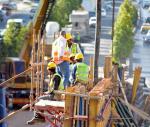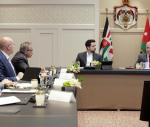You are here
Schools retrofitting priorities
Aug 06,2023 - Last updated at Aug 06,2023
A lot of interest in retrofitting schools and other public buildings in Jordan has been ongoing in the past years, and this has ignited a debate over the priority of retrofitting items within the economic management of many local and foreign institutions, particularly due to limited available budgets. Therefore, it is vital to investigate the priorities of various retrofitting items designed to suit the limited budgets in terms of return on investment, thermal comfort, structural integrity, safety and sustainability.
When retrofitting schools, make it a priority to consider consulting professionals experienced in local construction techniques, with sufficient knowledge of building material`s quality, prices and availability in the market on long term basis. This is important to insure the right choice of materials, its environmental impact, sustainable maintenance, efficiency and durability.
The other priority considered is safety to ensure that any retrofitting work prioritises safety measures, such as fire and flood safety, structural integrity of the building, hazard-free electro mechanical installations and safe building materials. For example, choosing a safe paint free of Volatile Organic Materials, avoiding asbestos-based materials and installing cameras to monitor student activities outside classrooms to safeguard vulnerable students from bullying and abuse.
As for safety concerning the structural integrity of the school, waterproofing the roof is a priority, because any rainwater or water flooding from the water tanks on the roofs can permeate through the roof and lead to the deterioration of the concrete and rusting of the reinforcement. Furthermore, wetting the roof in winter would cause moisture cracks on the roof as well as increasing heat losses due to reducing heat resistivity of the roof, rendering the thermal conditions in winter much colder inside classrooms.
Another criterion that safeguards structural integrity is making sure that any source of water, such as rain water, cesspool and underground reservoirs malfunction do not leak water into the foundations and underling susceptible ground soil that induces settlement and heaving, causing cracks in the building structure. Proper sidewalks and paved areas around the school, with a sloping surface away from the building, can also help avoid structural damage from running surface water. Planting trees should be as further away from the building as possible, especially when the soil is of an expansive nature.
The next priority is controlling air infiltration in winter by upgrading windows and maintaining them. Best to install is double glazed, if possible, making sure that air flow by infiltration in minimal. Surely differentiating between infiltration and ventilation is important as the latter is allowing a draft to occur, while the former refers to wind infiltrating through cracks in windows wherever there is contact between windows own frames or at the edges of window openings.
Shading is the next priority, as windows without shades can heat up glazing and internal spaces, therefore using simple curtains can shade classrooms from the soaring summer sun. Surely, horizontal shades are more efficient when installed outside southern windows, to shade the glazing and prevent sun rays from being transmitted inside; however, no shading is needed on the northern elevation. As for eastern and western elevations, vertical blinds are more effective than horizontal blinds due to the continuously changing angle of the rising and setting sun.
Although thermal insulation is the most important criterion for students at schools concerning the thermal comfort during all seasons, yet, we have unfairly placed it as a last priority. The only reason for that is cost. However, if the payback period on investment is considered as a criterion, no professional can disagree that the amount invested will be paid back in 2 to 5 years; that means earning an interest rate of 20 to 50 per cent on investment that no bank can afford giving.
The benefits of thermal insulation in schools are numerous, such as temperature regulation, as thermal insulation helps maintain a stable indoor temperature by reducing heat loss during colder months and heat gain during warmer months. This creates a comfortable environment for both students and teachers, promoting better focus and concentration in the classroom, thus improved academic performance. When students are not distracted by thermal discomfort or excessive noise, they are more likely to engage in learning activities effectively.
Thermal insulation often includes sound-absorbing materials that reduce echo and help dampen external noises, creating a quieter environment void of noise pollution inside classrooms. Reduced noise levels can enhance students' ability to concentrate on learning and teachers' ability to communicate effectively.
Stable indoor thermal conditions prevent extreme temperature fluctuations, which are known to contribute to illnesses such as flu. Additionally, well-insulated spaces with proper control of humidity levels are less prone to mold and dampness, which can improve air quality and reduce the risk of respiratory diseases.
Another benefit is energy efficiency, as proper insulation reduces the need for heating or cooling, leading to significant energy savings. This can result in lower utility bills for the school, allowing more resources to be allocated to educational programs and other essential needs. By reducing energy consumption, thermal insulation in schools contributes to a reduced carbon footprint, thus lower energy consumption means fewer greenhouse gas emissions, thereby helping combat climate change and promoting sustainability.
Proper thermal insulation can also protect the building's structural elements from temperature-related wear and tear, particularly thermal expansion and contraction due to fluctuating temperatures between day and night and summer and winter, thus preserving the integrity of the structure. This also prolongs the lifespan of the school building, reducing maintenance costs over time,
A vital question still remains: how should I insulate a public building or a school? What sort of insulating materials should I use, and where is the best place to put the thermal insulation: On the outside or on the inside?
The recommended thermal insulation for schools or any public buildings, such as a cinema or a lecture room, is one with a light thermal mass on the inside. For example, use five centimeters of extruded polystyrene or rock wool, or any equivalent material, covered with 18mm of cement or gypsum board on the inside. The light board will facilitate a quick warming up of the ambient air in winter once students occupy the classrooms, and adversely, facilitate quicker cooling when windows are opened in summer for cooling (considering no air conditioning is available).
Finally, retrofitting schools sends a positive message to students, staff, parents, and the community, demonstrating a commitment to environmental responsibility and compliance with building regulations, so we can avoid potential legal issues consolidate justice. Furthermore, we can enhance the school's reputation and attract community support once student`s safety, humanity and health are preserved.
Ayoub Abu Dayyeh is an energy and green buildings consultant













